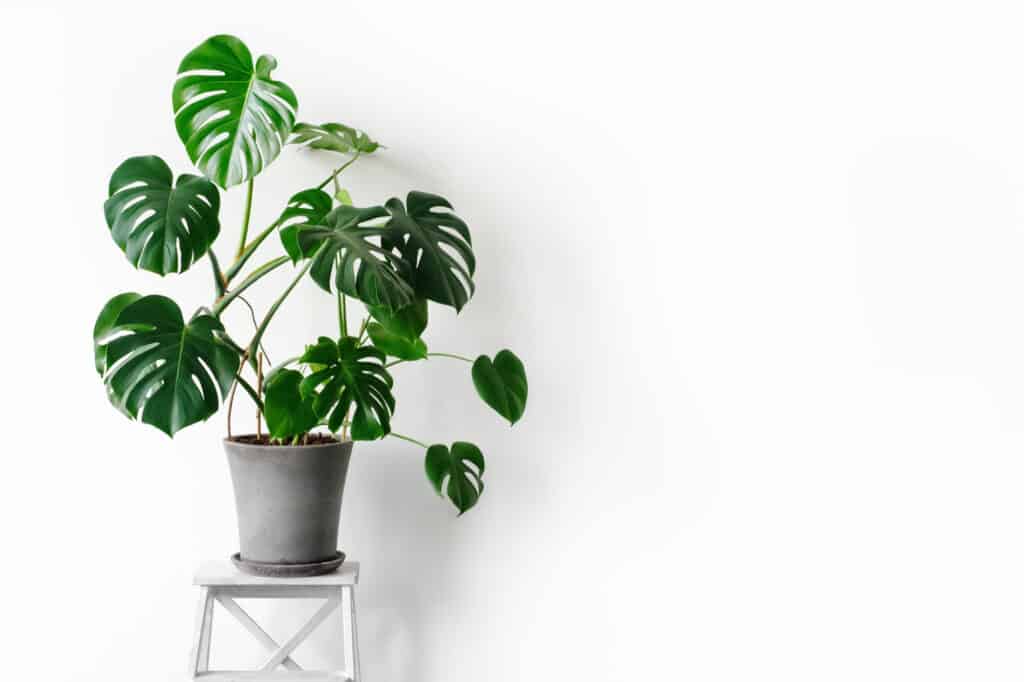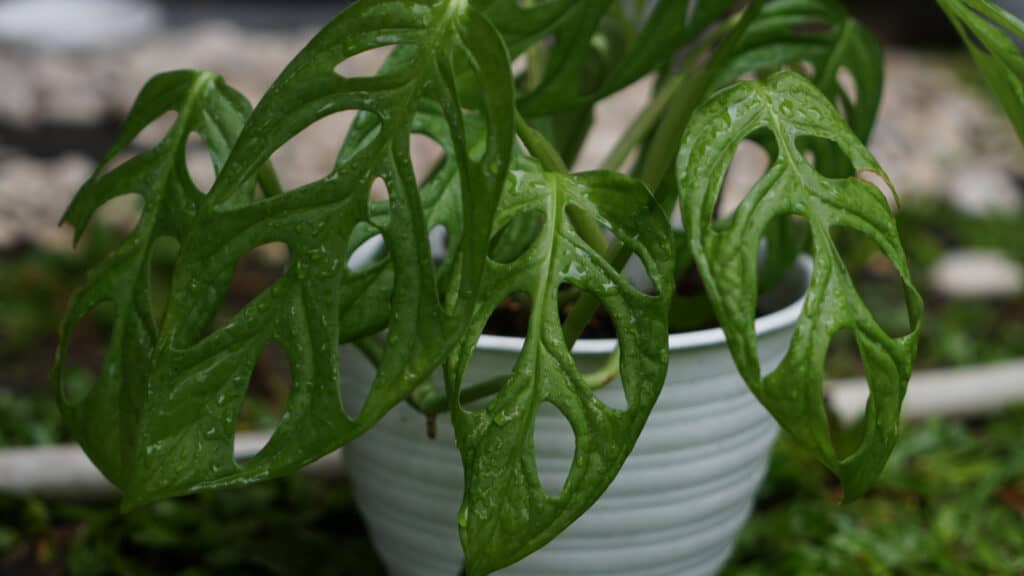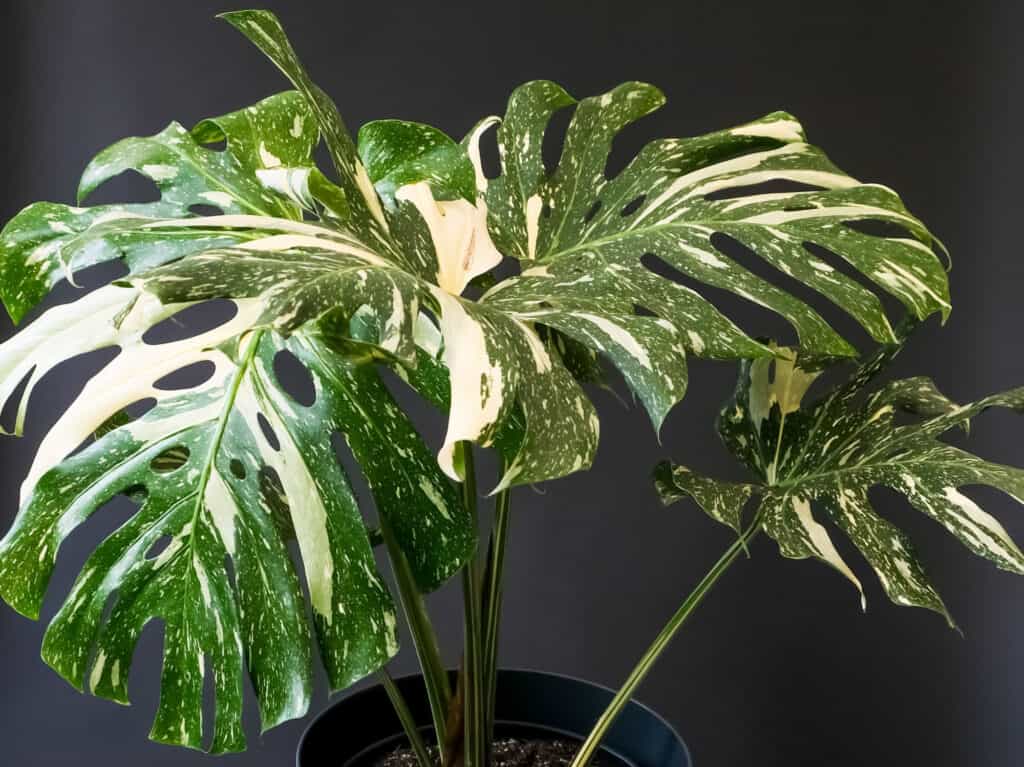Houseplants are frequently known by multiple names, and the Swiss cheese plant vs monstera is no exception. Are there truly any differences between a Swiss cheese plant and a monstera? Do they go by any other common names, and in what ways might these tropical plants be similar?
In this article, we will compare and contrast monstera plants with Swiss cheese plants so that you can fully understand the differences between them. Just as a hint: many people do not think there are any differences between monsteras and Swiss cheese plants! Let’s discuss all of these lines of thinking as well as what this beloved houseplant prefers in terms of its care.
Comparing Swiss Cheese Plant vs Monstera

Depending on who you ask, there are no real differences between a Swiss cheese plant and a monstera.
©Isabella Wand/Shutterstock.com
| Swiss Cheese Plant | Monstera | |
|---|---|---|
| Plant Classification | Monstera deliciosa or monstera adansonii | Multiple types of monsteras in the monstera plant genus |
| Native Location | Central and South America | Central and South America |
| Appearance | Green foliage with uniquely splitting leaves or leaves with rounded holes. Varies in height, depending on species | Green foliage and a climbing growth habit. Leaves have holes or splits in them and height depends on species |
| Care | Prefers bright, indirect light when grown indoors or partial shade when grown outdoors. Soil needs to be damp but not drenched and high temperatures is a must | Enjoys high humidity and bright, indirect light or partial shade. Damp and well-draining soil is important and temperatures should be over 65 degrees Fahrenheit |
| Other Names | Split-leaf philodendron, monstera deliciosa, monstera adansonii, monstera | Monstera deliciosa, monstera adansonii, Swiss cheese plant, shingle plant |
Key Differences Between Swiss Cheese Plant vs Monstera

Certain monstera species are better known by the name “Swiss cheese plant”, such as the monstera adansonii or the monstera deliciosa.
©ArtBackground/Shutterstock.com
Depending on who you ask, there are no real differences between a Swiss cheese plant and a monstera. The name “monstera” refers to the entire plant genus known by the same name and the Swiss cheese plant belongs to this genus. However, certain monstera species are better known by the name “Swiss cheese plant”, such as the monstera adansonii or the monstera deliciosa.
Let’s discuss monsteras and all of their various names, including the Swiss cheese plant, now.
Swiss Cheese Plant vs Monstera: Classification

The Swiss cheese plant is often classified as either monstera deliciosa or monstera adansonii.
©Sozina Kseniia/Shutterstock.com
There are a number of different potential plant classifications or scientific names for both the Swiss cheese plant and the monstera. This is because the name “monstera” technically refers to an entire plant genus as opposed to a singular plant. The name “Swiss cheese plant” is a common name for a few different types of monstera plants, making things a bit more confusing than necessary.
For example, the Swiss cheese plant is often classified as either monstera deliciosa or monstera adansonii. There are a few other possible monstera species that might be known as Swiss cheese plants, but these are the two primary monstera species known by this colloquial name. “Monstera” may refer to any type of monstera plant, as it is also a common, household name for any plants in this genus.
Swiss Cheese Plant vs Monstera: Appearance

The primary physical trait of both Swiss cheese plants and common monstera species is that most plants have holes or splits in their leaves.
©Iwan Widiyatno/Shutterstock.com
Depending on the type of monstera you have, there might be some differences in the appearance of a Swiss cheese plant and a monstera. However, given that these names are used interchangeably more often than not, monsteras and Swiss cheese plants may indeed appear identical!
The primary physical trait of both Swiss cheese plants and common monstera species is that most plants have holes or splits in their leaves. Their foliage is often large and delicate, found in shades of green. The holes on both the Swiss cheese plant and other monstera varieties grow more pronounced with age.
Swiss Cheese Plant vs Monstera: Care

If you want to take good care of any monstera, the Swiss cheese plant included, you should be sure to keep their soil consistently moist but not drowning.
©AngieYeoh/Shutterstock.com
No matter what type of monstera you have, they are all native to Central and South American tropical forests and humid regions. This means that both the Swiss cheese plant and the monstera thrive in high-humidity conditions and warm temperatures. If you want to take good care of any monstera, the Swiss cheese plant included, you should be sure to keep their soil consistently moist but not drowning and keep their delicate leaves out of harsh, direct sunshine!
Swiss Cheese Plant vs Monstera: Other Names

Both the Swiss cheese plant and the monstera thrive in high-humidity conditions and warm temperatures.
©Dan Gabriel Atanasie/Shutterstock.com
Given the fact that the names “monstera” and “Swiss cheese plant” are used interchangeably, you may be wondering if there are any other common names these plants are known by. More often than not, monstera species are also called split-leaf philodendrons or shingle plants, given their vining propensity. However, many plant experts choose to call their monsteras by their species name to avoid confusion, such as:
- Monstera deliciosa
- Monstera adansonii
- Monstera albo
- Monstera dubia
Up Next:
- Monstera Plant Care: How to Take Care of Your Monstera Houseplant
- Types of Monstera Plants: 9 Popular Varieties to Grow Now
- Swiss Cheese Plant: How to Care for This Unique Monstera
The photo featured at the top of this post is © Francois Louw/Shutterstock.com
Sources
- How Did the Swiss Cheese Plant Get Its Holes?, Available here: https://www.journals.uchicago.edu/doi/abs/10.1086/668819
Thank you for reading! Have some feedback for us? Contact the AZ Animals editorial team.






